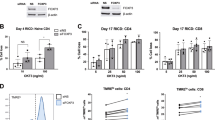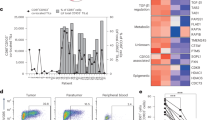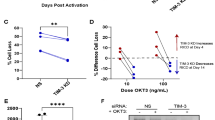Abstract
Ligation of TCRs on stimulated T cells leads to activation-induced cell death (AICD) resulting in the downregulation of immune responses, a process essential for T-cell homeostasis. In this study, using transformed T-cell lines such as Jurkat and Do11.10 as cellular models of TCR-mediated AICD, we have demonstrated that the proapoptotic protein Siva-1 is required for TCR-induced apoptosis. Knockdown of Siva-1 rendered T cells specifically resistant to anti-CD3 but not Fas-induced apoptosis. Further, we observed that in Siva-1 knockout Jurkat cells, TCR-mediated activation of the canonical and non-canonical limbs of the NF-κB pathway are significantly enhanced as reflected by elevated nuclear levels of p65 and RelB, respectively. In addition, loss of endogenous Siva-1 also resulted in the enhanced expression of NF-κB- responsive anti-apoptotic genes such as Bcl-xL and c-FLIP. Interestingly, the c-FLIPshort was detected only in TCR-ligated Siva-1 knockdown Jurkat cells. These results demonstrate a significant role for endogenous Siva-1, through its inhibitory effect on NF-κB activity, in TCR-mediated AICD with implications in peripheral tolerance, T-cell homeostasis and cancer.
This is a preview of subscription content, access via your institution
Access options
Subscribe to this journal
Receive 50 print issues and online access
$259.00 per year
only $5.18 per issue
Buy this article
- Purchase on Springer Link
- Instant access to full article PDF
Prices may be subject to local taxes which are calculated during checkout




Similar content being viewed by others
References
Bouillet P, Purton JF, Godfrey DI, Zhang LC, Coultas L, Puthalakath H et al. (2002). Nature 415: 922–926.
Brummelkamp TR, Bernards R, Agami R . (2002). Science 296: 550–553.
Cao C, Ren X, Kharbanda S, Koleske A, Prasad KVS, Kufe D . (2001). J Biol Chem 276: 11465–11468.
Chu F, Barkinge J, Hawkins S, Gudi R, Salgia R, Prasad KVS . (2005). Cancer Res 12: 5301–5309.
Chu F, Borthakur A, Sun X, Barkinge J, Gudi R, Hawkins S et al. (2004). Apoptosis 9: 83–95.
Ghosh S, Karin M . (2002). Cell suppl 109: S81–S96.
Green DR, Droin N, Pinkoski M . (2003). Immunol Rev 193: 70–81.
Hauer J, Puschner S, Ramakrishnan P, Simon U, Bongers M, Federle C et al. (2005). Proc Natl Acad Sci USA 102: 2874–2879.
Henke A, Launhardt H, Klement K, Stelzner A, Zell R, Munder T . (2000). J Virol 74: 4284–4290.
Hildeman DA, Zhu Y, Mitchell TC, Kappler J, Marrack P . (2002). Curr Opin Immunol 14: 354–359.
Li Y, Sedwick CE, Hu J, Altman A . (2005). J Biol Chem 280: 1217–1223.
Muller MM, Schreiber E, Schaffner W, Matthias P . (1989). Nucleic Acids Res 17: 6420.
Nossal GJ . (1994). Cell 76: 229–239.
Prasad KV, Ao Z, Yoon Y, Wu MX, Rizk M, Jacquot S et al. (1997). Proc Natl Acad Sci USA 94: 6346–6351.
Schmitz I, Weyd H, Krueger A, Baumann S, Fas SC, Krammer PH et al. (2004). J Immunol 172: 2194–2200.
Spinicelli S, Nocentini G, Ronchetti S, Krausz LT, Bianchini R, Riccardi C . (2002). Cell Death Differ 9: 1382–1384.
Wan YY, DeGregori J . (2003). Immunity 18: 331–343.
Xiao N, Chunlei Z, Rakhashandra T, Madeleine D . (2005). Lymphoma J Invest Dermatol 124: 741–750.
Xue L, Chu F, Cheng Y, Sun X, Borthakur A, Ramarao M et al. (2002). Proc Natl Acad Sci USA 99: 6925–6930.
Yoon Y, Ao Z, Cheng Y, Schlossman SF, Prasad KV . (1999). Oncogene 18: 7174–7179.
Acknowledgements
We thank Drs B. Prabhakar and C. Vasu (UIC) for helpful comments and Drs T. Hope (North Western University) and B. Cullen (Duke University) for providing the lentiviral siRNA vector. The anti-CD3 antibodies (OKT3 and 2C11) and anti-FLIP (NF-6) antibody were kind gifts from Drs Gordon Freeman (Harvard University) and Marcus Peter (University of Chicago), respectively.
Author information
Authors and Affiliations
Corresponding author
Additional information
Supplementary Information accompanies the paper on Oncogene website (http://www.nature.com/onc)
Supplementary information
Rights and permissions
About this article
Cite this article
Gudi, R., Barkinge, J., Hawkins, S. et al. Siva-1 negatively regulates NF-κB activity: effect on T-cell receptor-mediated activation-induced cell death (AICD). Oncogene 25, 3458–3462 (2006). https://doi.org/10.1038/sj.onc.1209381
Received:
Revised:
Accepted:
Published:
Issue Date:
DOI: https://doi.org/10.1038/sj.onc.1209381
Keywords
This article is cited by
-
Siva plays a critical role in mouse embryonic development
Cell Death & Differentiation (2020)
-
Multifaceted functions of Siva-1: more than an Indian God of Destruction
Protein & Cell (2012)
-
Regulation of IL-2 gene expression by Siva and FOXP3 in human T cells
BMC Immunology (2011)



